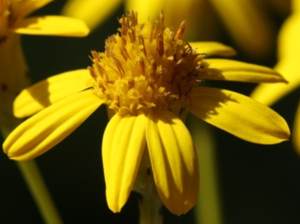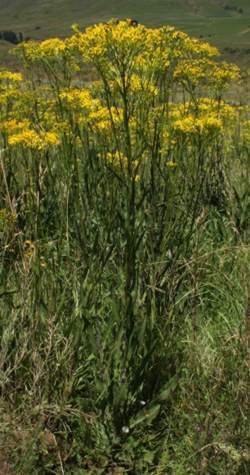Senecio inornatus
Senecio inornatus DC.
Family: Asteraceae
Common names: tall marsh senecio (Eng.); groot vlei-senecio (Afr.); Inkanga, Uhlabo (isiZulu); Lehlongoana-le-leholo (Southern Sotho).
Introduction
Senecio inornatus is a tall robust plant that does not go unnoticed in any grassland or wetland. These solitary plants are often much taller than the surrounding grass and in moist areas large numbers of plants often dominate the landscape; their bright yellow flowers and honey-like scent attracting many insects.

Description
Description
Senecio inornatus is a robust perennial herb with one or more stems from an underground rootstock, reaching up to 2m high. Plants are usually hairless but can also be covered by a white cobwebby woolly layer. Most of the leaves are basal and can be up to 500×35mm, diminishing in size upwards along the stem, generally sessile and narrowing to both ends. The leaf blade often extends somewhat along the stem at the base. Leaf margins are dentate, but usually only have small wart-like outgrowths along margins.

The compound inflorescences are flat-topped, with numerous small flowerheads. Involucral bracts (bracts surrounding the base of the flowerhead) consist of about 10-12 in a single row, with a few, much shorter calyculus bracts (the bracts around the involucre). Capitula (dense head-like inflorescences) are radiate with 5-8 ray florets. Florets are yellow. Flowering time is from December to March.

Conservation Status
Status
Senecio inornatus is Red Listed as Least Concern (LC); it is not threatened. This species is quite common and widespread and rather tends towards becoming weedy.
Distribution and habitat
Distribution description
Senecio inornatus occurs along grassland and forest margins, on moist grassy mountain slopes, in marshy patches, along roadsides and stream banks; from the coast up to an altitude of 3000m.

This species is very common in the Eastern Cape, Free State, Gauteng, KwaZulu-Natal, Limpopo, Mpumalanga, North-West and Swaziland. It is also found in Namibia, Angola, Zambia, Zimbabwe and other tropical African countries.
Derivation of name and historical aspects
History
A member of the Asteraceae (daisy family), the genus Senecio consists of over 1000 species worldwide and is considered to be one of the largest genera of flowering plants in the world. The genus includes common perennial or annual weeds.
The genus name Senecio is derived from the Latin word senex meaning old man, which refers to the grey hairs on the seeds. The species name inornatus means modest or not ornamental.
Ecology
Ecology
Senecio inornatus is visited by a variety of insects, including ants and stingless bees. The flowers attract butterflies, and the larvae of tricoloured tiger and Delegorgue's prince moths feed on Senecio species. Seeds are dispersed by wind or water.
Uses
Use
Senecio inornatus is used extensively in traditional medicine to treat palpitations, phthisis, coughs and difficult breathing. Incorrect application of and treatment with this plant can be dangerous as it contains highly toxic alkaloids that may cause liver damage.
Growing Senecio inornatus
Grow
There are no records of Senecio inornatus being cultivated in gardens. It is usually harvested from the wild. However, if anyone would like to establish or reclaim a wetland it would be worth cultivating S. inornatus from seed or rootstocks. This is a fast and robust grower and will assist in stabilising the ecosystem.

References
- Beentje, H., Hind, D.J.N. & Jefferey, C. 2005. Flora of Tropical East Africa , Vol Part 3: 547.
- Davy, J.B. & Hutchinson, J. 1936. New or Noteworthy South African Plants. VIII New Compositae from the Transvaal. Index Kewensis : 81-85.
- Harvey, W.H. 1894. Flora capensis , Vol. 3: 44.
- Herman, P.P.J. & Retief, E. 1997. Plants of the Northern Provinces of South Africa: keys and diagnostic characters. Strelitzia 6. National Botanical Institute.
- http://www.calflora.net. The Eponym Dictionary of Southern African Plants. Accessed on: 3 March 2014.
- http://www.desert-tropicals.com . Senecio . Accessed on: 18 March 2014.
- http://www.plantzafrica.com . Senecio tamotoides . Accessed on: 01 April 2014.
- http://eol.org. Senecio inornatus . Accessed on: 26 Feruary 2014.
Credits
Cynthia Mikateko Baloyi & Marinda Koekemoer
Pretoria National Herbarium
April 2014
Plant Attributes:
Plant Type: Perennial
SA Distribution: Eastern Cape, Free State, Gauteng, KwaZulu-Natal, Limpopo, Mpumalanga, North West
Soil type: Sandy, Loam
Flowering season: Late Summer
PH: Acid, Neutral
Flower colour: Yellow
Aspect: Full Sun
Gardening skill: Easy
Special Features:
Horticultural zones











Rate this article
Article well written and informative
Rate this plant
Is this an interesting plant?
Login to add your Comment
Back to topNot registered yet? Click here to register.